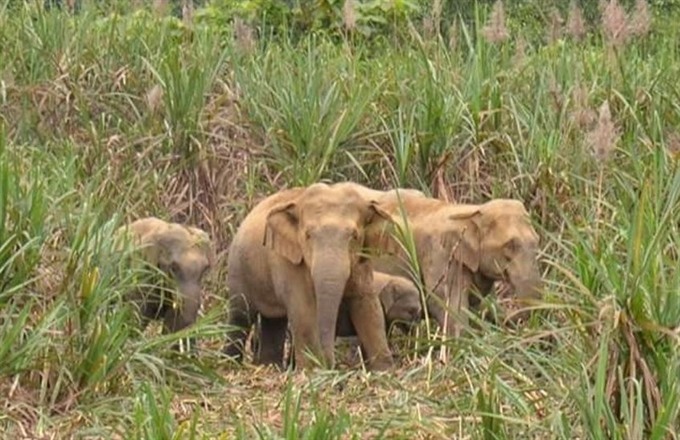 Environment
Environment

For centuries, residents in Phúc Sơn Commune, central province of Nghệ An have lived comfortably with wild elephants, but as bamboo forests - the main diet of many elephants - are replaced with industrial trees, things are changing. Many elephant herds are now finding it difficult to find enough food to survive
 |
| Elephants at the Pù Mát National Park in the central province of Nghệ An. Many elephant herds in the province are now finding it difficult to find enough food to survive. — Photo: baonghean.vn |
NGHỆ AN — For centuries, residents in Phúc Sơn Commune, central province of Nghệ An have lived comfortably with wild elephants, but as bamboo forests - the main diet of many elephants - are replaced with industrial trees, things are changing. Many elephant herds are now finding it difficult to find enough food to survive.
Last October, six wild elephants went on a rampage in a commune village and destroyed family crops.
The family called neighbours for help to chase the elephants away. However, the wild beasts refused to go until they had destroyed two hectares of acacias and other trees.
A resident, Lương Văn Tình from Vều 3 Village, said that elephants once arrived the commune at about 2am and refused to leave even though people tried all means to make them go away.
In 2014, several elephants arrived when people were celebrating Tết (Lunar New Year) festival.
“The elephants were so aggressive. They appeared to be looking for something to destroy. They even wrecked the kitchen of one family before running off,” Tình said.
In 2011, elephants, killed one man and destroyed many tents. In a similar case in 2013, one person died and four people were injured.
“We are so worried about unwelcome visits from wild elephants,” Tình said.
Other localities in Nghệ An province have also reported the angry behavious of many wild elephants in places such as Bắc Sơn Commune in Quỳ Hợp District, Thanh Đức Commune in Thanh Chương District, the communes of Môn Sơn, Lục Dạ, Chi Khê, Yên Khê in Con Cuông District and Xá Lượng Commune in Tương Dương District.
It is reported that there are only about 13 to 15 wild elephants in the province. They are in two herds, one living in Khe Thơi in the core of Pù Mát National Park while the other lives in a park buffer zone belonging to Phúc Sơn Commune.
Trần Xuân Cường, director of Pù Mát National Park said that the park was one of three elephant conservation centres in Việt Nam. The others were in the in Central Highland province of Đắk Lắk and the southern province of Đồng Nai.
Previously, there used to be about 1,500ha of bamboo forest providing food to the elephants but now, bamboo has been replaced by industrial trees.
“As elephants’ feeding places shrink, they are forced to go to residential or farming areas to search for food,” Cường said.
“In 2010, an elephant was shot to dead in a forest in Phúc Sơn Commune, so now there are only six elephants in the herd - probably not enough for them to breed and survive.”
In 2013, Nghệ An Province People’s Committee approved a project worth VNĐ86 billion (US$3.87 million) to try and save the few remaining elephants.
Under the project, elephant habitat is supposed to be protected to ensure viable living conditions and sustainable development for wild elephants.
The move was also aimed at curbing the conflicts between elephants and people, at least preventing the intrusion of elephants on residential or farming areas.
As a part of the project, a 5-km-long trench was planned to be built in Vều 1 and Vều 2 villages in Phúc Sơn Commune to separate elephant terriroty from residential areas.
Lack of funding is blamed for lack of progress in digging the trench and carrying out other important work, such as the restoration of 250-ha habitat for elephants, Sài Gòn Giải Phóng (Liberated Sài Gòn) newspaper reported.
Nguyễn Văn Tráng, chairman of Phúc Sơn Commune People’s Committee said that villagers were still worried about visits from elephants.
He admitted he had reservations about building a trench because it would limit the elephants too much and they would be forced to go to other areas looking for food. — VNS